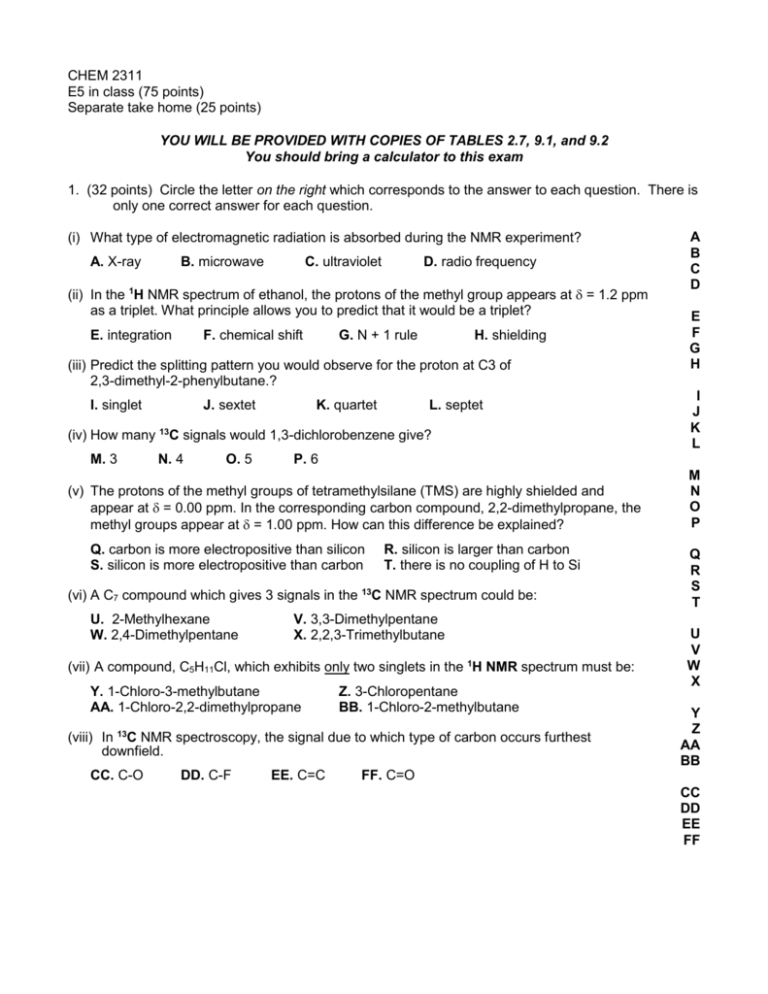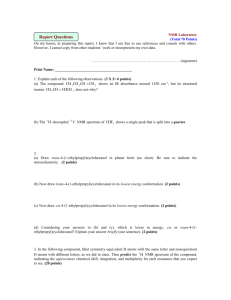CHEM 2311
advertisement

CHEM 2311 E5 in class (75 points) Separate take home (25 points) YOU WILL BE PROVIDED WITH COPIES OF TABLES 2.7, 9.1, and 9.2 You should bring a calculator to this exam 1. (32 points) Circle the letter on the right which corresponds to the answer to each question. There is only one correct answer for each question. (i) What type of electromagnetic radiation is absorbed during the NMR experiment? A. X-ray B. microwave C. ultraviolet D. radio frequency (ii) In the 1H NMR spectrum of ethanol, the protons of the methyl group appears at = 1.2 ppm as a triplet. What principle allows you to predict that it would be a triplet? E. integration F. chemical shift G. N + 1 rule H. shielding (iii) Predict the splitting pattern you would observe for the proton at C3 of 2,3-dimethyl-2-phenylbutane.? I. singlet J. sextet K. quartet L. septet (iv) How many 13C signals would 1,3-dichlorobenzene give? M. 3 N. 4 O. 5 Q. carbon is more electropositive than silicon S. silicon is more electropositive than carbon R. silicon is larger than carbon T. there is no coupling of H to Si (vi) A C7 compound which gives 3 signals in the 13C NMR spectrum could be: V. 3,3-Dimethylpentane X. 2,2,3-Trimethylbutane (vii) A compound, C5H11Cl, which exhibits only two singlets in the 1H NMR spectrum must be: Y. 1-Chloro-3-methylbutane AA. 1-Chloro-2,2-dimethylpropane Z. 3-Chloropentane BB. 1-Chloro-2-methylbutane 13 (viii) In C NMR spectroscopy, the signal due to which type of carbon occurs furthest downfield. CC. C-O DD. C-F E F G H I J K L P. 6 (v) The protons of the methyl groups of tetramethylsilane (TMS) are highly shielded and appear at = 0.00 ppm. In the corresponding carbon compound, 2,2-dimethylpropane, the methyl groups appear at = 1.00 ppm. How can this difference be explained? U. 2-Methylhexane W. 2,4-Dimethylpentane A B C D EE. C=C M N O P Q R S T U V W X Y Z AA BB FF. C=O CC DD EE FF 2. (24 points) (a) Provide a single structure consistent with the following data (there is a single correct answer for each part). (i) Compound A: C3H6O which boils at 78 °C (the highest boiling C3H6O compound) (ii) Compound B: C3H7Br 1 H NMR: a septet (1H) downfield from a doublet (6H) (iii) Compound C: C5H12O 1 H NMR: two singlets (iv) Compound D: C8H8Cl2 1 H NMR: two singlets (b) Compound E, which contains only C, H, and O gives a combustion analysis of C55.82%; H 6.94% (i) What is the empirical formula of E? (ii) What is the smallest possible molecular formula for E? 3. (19 points) Refer to the data provided on the next page. NOTE: Parts (a)-(i) are worth TWO POINTS each, (j) is worth ONE POINT. Each part is graded independently, without reference to other answers Analysis of Combustion Analysis/Mass Spectrum/Empirical Formula (a) What is the molecular formula? (b) What is the value of SODAR? Analysis of the 13C NMR spectrum: (c) How many types of carbon are there in the molecule: (d) Is a carbonyl present? (circle one) Yes No (e) How many types of aromatic carbons are there? Analysis of IR spectrum (in conjunction with formula and 13C NMR) (f) Which of the following are present? (circle all that are present) O-H C-O C=O Analysis of 1H NMR spectrum (g) How many types of proton are there in the molecule? (h) What is the ratio of the number of each type of proton? (i.e., 6:3:2:1) (i) How many aromatic hydrogens are there? Putting it all together (j) Suggest a single structure for the molecule. E1 Practice-i, q3 Empirical Formula: Empirical Formula: C4H5C O4H5O Spec: M+ m/e= MassMass Spec: M+ m/e= 138 138 IR transmittance transmittance 50 0 • 13C 100 100 50 0 13C NMR NMR 3000 2000 1500 Wavenumber Wavenumber / cm-1 / cm-1 1000 500 1H 1H NMR NMR Spectra from sbds







